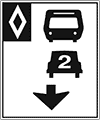GENERAL TIPS
HOV Lanes

HOV (High Occupancy Vehicle) lanes are designed to help move more people through congested areas. HOV lanes offer users a faster, more reliable commute, while also easing congestion in regular lanes - by moving more people in fewer vehicles.
HOV lanes on Highway 403 and 404 are the inside (leftmost) lane and are identified by signs and diamond symbols on the pavement. The HOV lane is separated from the other general traffic lanes by a striped buffer zone. Vehicles carrying at least two people may enter and exit the HOV lane only at designated points, clearly identifiable by wide and closely spaced white broken lines and diamond symbol pavement markings.
HOV Lane Rules
HOV lane rules are enforced like any other rule of the road.
The HOV lane is separated from the other general traffic lanes by a striped buffer zone. It is illegal and unsafe to cross the striped buffer pavement markings. HOV lanes are open 24 hours a day, 7 days a week.
Who can use HOV lanes?
HOV lanes on provincial highways are reserved for any of the following passenger vehicles carrying at least two people (often referred to as 2 +):
- Car
- Commercial truck less than 6.5 metres long
- Minivan
- Motorcycle
- Taxi or limousine
- Bus
A bus of any type can use an HOV lane, even without passengers. This helps buses keep to their schedules and provide reliable, efficient service.
Emergency vehicles are permitted to use the HOV lanes at all times.
Which vehicles are NOT allowed to use HOV lanes?
- A vehicle with only the driver
- Motorcycles with only the driver
- Commercial trucks greater than 6.5 metres in length or with a gross weight of more than 4,500 kg
- Taxis or limousines without a fare
Who counts as a passenger?
For the purposes of HOV lane travel, adults and children occupying a seat are considered passengers. There are no restrictions on the age of a passenger in the HOV lane.
Advantages of High Occupancy Vehicle Lanes
Although our highways are congested with trucks and cars, they still can carry several thousand people. Part of the problem is people drive with three or four empty seats, even during the most congested day. One solution is to encourage more commuters to join carpools and take transit than drive alone.
High occupancy vehicle lanes are made specifically for the use of carpools and buses. HOV lanes are intended to provide fast, reliable travel for HOV users at any time of the day - especially during the period when other lanes can be slow and congested.
Impaired driving is a problem that seriously affects the safety of our roads. Every year in Canada more than 1,100 people die in alcohol- related collisions - that's about one-third of the total number of fatalities. Thousands more are injured, many of them permanently disabled. In fact, nearly 40 per cent of seriously injured drivers consumed alcohol prior to their collisions.
